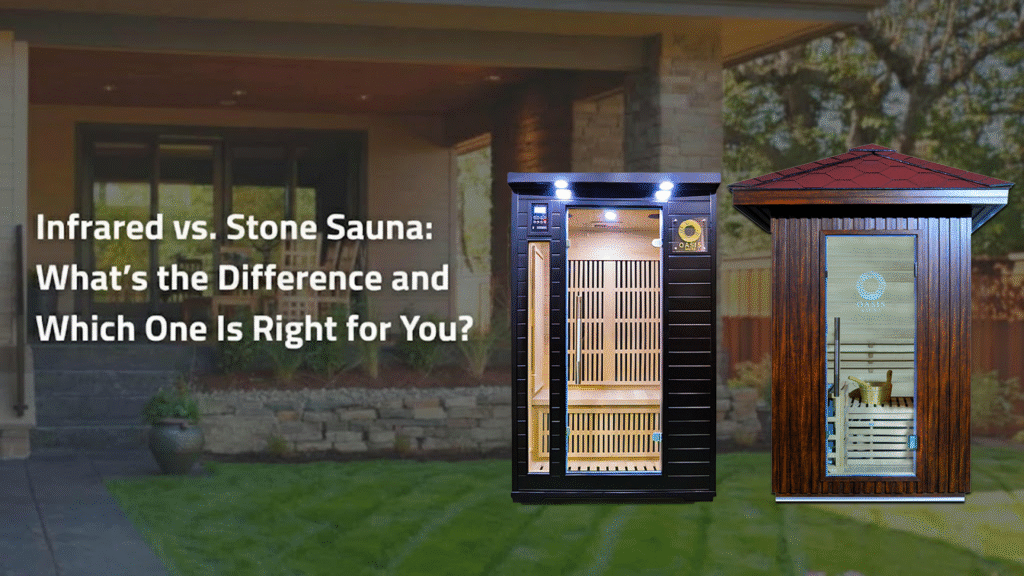
Infrared vs. Stone Sauna:
What’s the Difference and Which One Is Right for You?
Saunas have been cherished for centuries as sanctuaries of relaxation and healing. But as wellness technology evolves, so do our choices. Today, the two most common types are the infrared sauna and the traditional stone sauna (also called a Finnish or dry sauna). While both deliver powerful health benefits — from improved circulation to stress relief — they work in very different ways. Understanding those differences can help you decide which experience best suits your lifestyle and wellness goals.
1. How They Heat: Air vs. Body
The most fundamental difference lies in how heat is produced and transferred.
Stone Sauna: This is the classic sauna most people imagine — a wooden room heated by a stove filled with volcanic stones. The stove raises the air temperature, and you absorb heat indirectly through the hot air and surfaces. Pouring water over the stones produces bursts of steam, briefly increasing humidity and intensifying the sensation.
Infrared Sauna: Instead of heating the air, infrared saunas use specialized heaters that emit infrared light waves, which penetrate the skin and heat the body directly. The air temperature remains relatively mild, but your core temperature still rises from within.
Key takeaway: Stone saunas heat the room first and your body second; infrared saunas heat your body directly without significantly warming the air.
2. Temperature and Comfort Levels
Stone Sauna: Typically operates at 75–100 °C (167–212 °F). The air feels hot and intense, and many users enjoy the ritual of short, repeated sessions with breaks in between. Some find the heat invigorating; others may feel it’s overwhelming, especially on the lungs.
Infrared Sauna: Much gentler, usually 45–65 °C (113–149 °F). Despite the lower air temperature, your core temperature rises similarly — often resulting in a deep sweat. Because the heat is less stifling, many people stay inside longer and find it easier to breathe.
Key takeaway: Stone saunas deliver a more traditional, intense heat, while infrared saunas offer a gentler, more comfortable experience.
3. Health Benefits: Shared and Unique
Both sauna types promote detoxification, relaxation, improved circulation, and muscle recovery — but they do so through slightly different mechanisms.
Stone Sauna Benefits:
Rapid sweating and increased heart rate similar to moderate exercise
Deep relaxation from the enveloping heat
A strong immune boost due to quick body temperature spikes
Enhanced respiratory benefits from alternating heat and steam (if water is added)
Infrared Sauna Benefits:
Deeper tissue penetration (up to 4–5 cm beneath the skin)
Effective muscle and joint pain relief, making it popular for arthritis and injury recovery
Potential for improved skin health due to deeper sweating at lower temperatures
More accessible for people sensitive to extreme heat or with cardiovascular concerns
Key takeaway: Stone saunas excel at cardiovascular conditioning and traditional heat therapy, while infrared saunas shine in deeper detoxification, pain relief, and comfort.
4. Ritual vs. Convenience
Stone Sauna: The experience is often more ritualistic — preheating the sauna, pouring water over stones, and moving between hot and cold phases. It’s social, immersive, and rooted in tradition. However, warm-up time can take 30–45 minutes.
Infrared Sauna: Heats up faster (usually 10–15 minutes) and doesn’t require water or stones. This makes it ideal for quick, daily use — even in small spaces like apartments or home gyms.
Key takeaway: If you love ritual, tradition, and a social spa-like atmosphere, go for stone. If you value speed and ease, infrared wins.
5. Energy Use and Maintenance
Stone Sauna: Consumes more energy due to higher operating temperatures. Maintenance includes cleaning stones, ensuring proper ventilation, and periodically replacing heating elements.
Infrared Sauna: Generally more energy-efficient and lower-maintenance. The panels last many years, and no stones or water are involved.
Key takeaway: Infrared saunas are more efficient and convenient, while stone saunas require more energy but offer an authentic spa experience.
